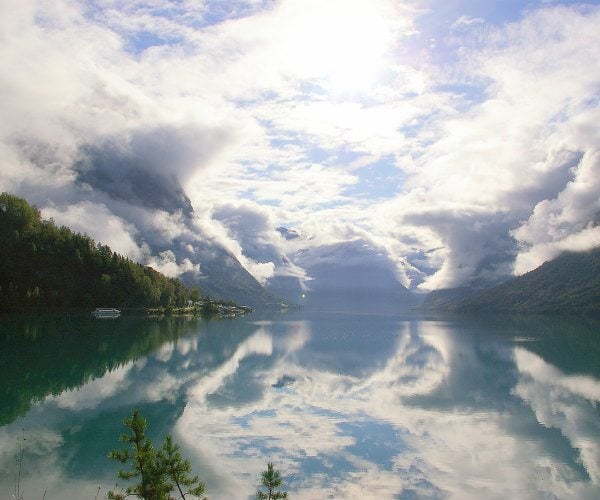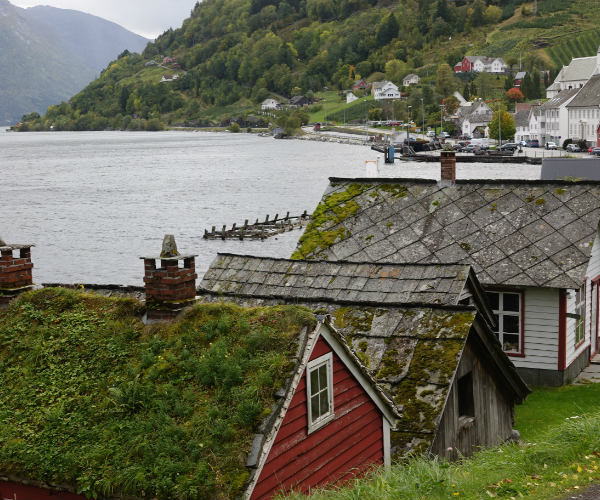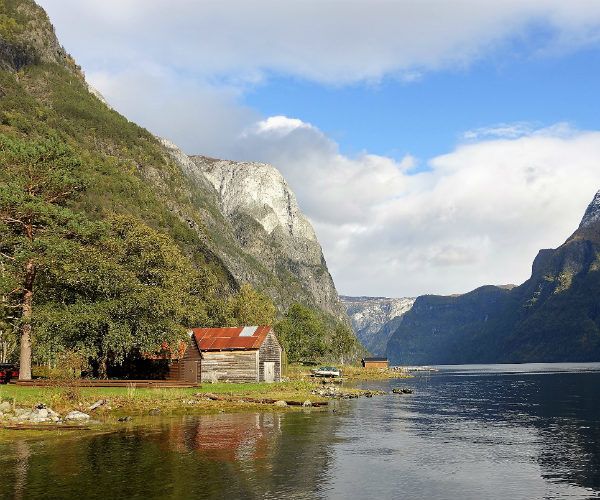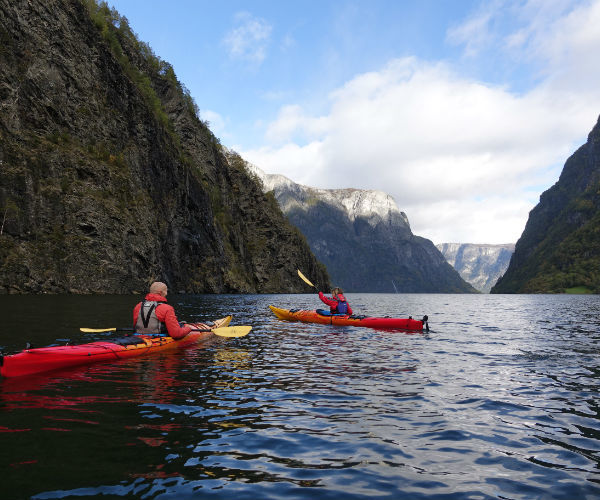Europe · Norway · Regions · Western Europe
How water has shaped Norwegian culture
We all know that water sustains life. But for Norwegians, whose population is concentrated along the coasts where the famous fjords dramatically cut into the landscape, water has literally shaped their culture. It’s in their heritage—Vikings, after all, were incredibly successful seafarers. They colonized as far away as Greenland and the country of Georgia navigating open water and river systems.
 While there are many miles of roads in Norway, much of the transportation remains water-based. It’s common for drivers to wait patiently for the short 10-minute ferries that chug across waterways connecting the end of one road with the start of another. Residents in neighboring villages visit each other and exchange goods and services by hopping on scheduled, public ferries (just like buses). These village-to-village trips used to be much slower and weather dependent, which explains why each little hamlet has a distinct feel and character. This relative isolation in which many fjord villages existed left an impression on Norwegian culture.
While there are many miles of roads in Norway, much of the transportation remains water-based. It’s common for drivers to wait patiently for the short 10-minute ferries that chug across waterways connecting the end of one road with the start of another. Residents in neighboring villages visit each other and exchange goods and services by hopping on scheduled, public ferries (just like buses). These village-to-village trips used to be much slower and weather dependent, which explains why each little hamlet has a distinct feel and character. This relative isolation in which many fjord villages existed left an impression on Norwegian culture.
 Historically, and often still today, everyday supplies were hard to acquire, so folk songs encourage using everything without any waste. Water-related jobs employ many Norwegians, and seafood (as you will find out when you go) is a mainstay of the cuisine. Since outside food sources are also difficult to get, farmers practice sustainable agriculture to nurture as much as possible from their land while keeping it healthy and productive over the long-term. In fact, the edges of the fjords and river valleys have some of the most fertile soil in the country.
Historically, and often still today, everyday supplies were hard to acquire, so folk songs encourage using everything without any waste. Water-related jobs employ many Norwegians, and seafood (as you will find out when you go) is a mainstay of the cuisine. Since outside food sources are also difficult to get, farmers practice sustainable agriculture to nurture as much as possible from their land while keeping it healthy and productive over the long-term. In fact, the edges of the fjords and river valleys have some of the most fertile soil in the country.
 The fjords are a source of pride for those living among them. Each one is known for something special— one is the narrowest, one is the longest, another is the deepest, etc.—and they all claim to be the most beautiful (they are, in fact, all gorgeous!). Their unique geography has most certainly affected the Norwegian’s appetite for all things outdoors. The abundance of water encourages kayakers and boaters for recreation and quick transportation. Fishing is a common hobby and source of income. The steep slopes offer incredible hiking and skiing. Ancient blue-hued glaciers provide breathtaking adventure. Norwegians celebrate the benefits and the beauty of their natural environment with festivals for local food and extreme sports, and parents even put babies outside to nap as they know fresh air is good for them!
The fjords are a source of pride for those living among them. Each one is known for something special— one is the narrowest, one is the longest, another is the deepest, etc.—and they all claim to be the most beautiful (they are, in fact, all gorgeous!). Their unique geography has most certainly affected the Norwegian’s appetite for all things outdoors. The abundance of water encourages kayakers and boaters for recreation and quick transportation. Fishing is a common hobby and source of income. The steep slopes offer incredible hiking and skiing. Ancient blue-hued glaciers provide breathtaking adventure. Norwegians celebrate the benefits and the beauty of their natural environment with festivals for local food and extreme sports, and parents even put babies outside to nap as they know fresh air is good for them!
 In short, delving into Norway’s “waterific” landscape of fjords, waterfalls, rivers, and glaciers is vital to understanding the Norwegian culture, history, and way of life. Plus, it’s really quite beautiful.
Matt Holmes is the Founder & President of Boundless Journeys. Boundless Journeys is an award-winning tour operator that goes off the beaten path for immersive and authentic travel experiences.
If you would like to be a guest blogger on A Luxury Travel Blog in order to raise your profile, please contact us.
In short, delving into Norway’s “waterific” landscape of fjords, waterfalls, rivers, and glaciers is vital to understanding the Norwegian culture, history, and way of life. Plus, it’s really quite beautiful.
Matt Holmes is the Founder & President of Boundless Journeys. Boundless Journeys is an award-winning tour operator that goes off the beaten path for immersive and authentic travel experiences.
If you would like to be a guest blogger on A Luxury Travel Blog in order to raise your profile, please contact us.
 While there are many miles of roads in Norway, much of the transportation remains water-based. It’s common for drivers to wait patiently for the short 10-minute ferries that chug across waterways connecting the end of one road with the start of another. Residents in neighboring villages visit each other and exchange goods and services by hopping on scheduled, public ferries (just like buses). These village-to-village trips used to be much slower and weather dependent, which explains why each little hamlet has a distinct feel and character. This relative isolation in which many fjord villages existed left an impression on Norwegian culture.
While there are many miles of roads in Norway, much of the transportation remains water-based. It’s common for drivers to wait patiently for the short 10-minute ferries that chug across waterways connecting the end of one road with the start of another. Residents in neighboring villages visit each other and exchange goods and services by hopping on scheduled, public ferries (just like buses). These village-to-village trips used to be much slower and weather dependent, which explains why each little hamlet has a distinct feel and character. This relative isolation in which many fjord villages existed left an impression on Norwegian culture.
 Historically, and often still today, everyday supplies were hard to acquire, so folk songs encourage using everything without any waste. Water-related jobs employ many Norwegians, and seafood (as you will find out when you go) is a mainstay of the cuisine. Since outside food sources are also difficult to get, farmers practice sustainable agriculture to nurture as much as possible from their land while keeping it healthy and productive over the long-term. In fact, the edges of the fjords and river valleys have some of the most fertile soil in the country.
Historically, and often still today, everyday supplies were hard to acquire, so folk songs encourage using everything without any waste. Water-related jobs employ many Norwegians, and seafood (as you will find out when you go) is a mainstay of the cuisine. Since outside food sources are also difficult to get, farmers practice sustainable agriculture to nurture as much as possible from their land while keeping it healthy and productive over the long-term. In fact, the edges of the fjords and river valleys have some of the most fertile soil in the country.
 The fjords are a source of pride for those living among them. Each one is known for something special— one is the narrowest, one is the longest, another is the deepest, etc.—and they all claim to be the most beautiful (they are, in fact, all gorgeous!). Their unique geography has most certainly affected the Norwegian’s appetite for all things outdoors. The abundance of water encourages kayakers and boaters for recreation and quick transportation. Fishing is a common hobby and source of income. The steep slopes offer incredible hiking and skiing. Ancient blue-hued glaciers provide breathtaking adventure. Norwegians celebrate the benefits and the beauty of their natural environment with festivals for local food and extreme sports, and parents even put babies outside to nap as they know fresh air is good for them!
The fjords are a source of pride for those living among them. Each one is known for something special— one is the narrowest, one is the longest, another is the deepest, etc.—and they all claim to be the most beautiful (they are, in fact, all gorgeous!). Their unique geography has most certainly affected the Norwegian’s appetite for all things outdoors. The abundance of water encourages kayakers and boaters for recreation and quick transportation. Fishing is a common hobby and source of income. The steep slopes offer incredible hiking and skiing. Ancient blue-hued glaciers provide breathtaking adventure. Norwegians celebrate the benefits and the beauty of their natural environment with festivals for local food and extreme sports, and parents even put babies outside to nap as they know fresh air is good for them!
 In short, delving into Norway’s “waterific” landscape of fjords, waterfalls, rivers, and glaciers is vital to understanding the Norwegian culture, history, and way of life. Plus, it’s really quite beautiful.
Matt Holmes is the Founder & President of Boundless Journeys. Boundless Journeys is an award-winning tour operator that goes off the beaten path for immersive and authentic travel experiences.
If you would like to be a guest blogger on A Luxury Travel Blog in order to raise your profile, please contact us.
In short, delving into Norway’s “waterific” landscape of fjords, waterfalls, rivers, and glaciers is vital to understanding the Norwegian culture, history, and way of life. Plus, it’s really quite beautiful.
Matt Holmes is the Founder & President of Boundless Journeys. Boundless Journeys is an award-winning tour operator that goes off the beaten path for immersive and authentic travel experiences.
If you would like to be a guest blogger on A Luxury Travel Blog in order to raise your profile, please contact us.Did you enjoy this article?
Receive similar content direct to your inbox.


If you have ever seen a Viking ship you’ll be amazed that the Norwegians were able to navigate as far as Georgia. I’ve actually rowed on a Viking boat at the Viking Ship Museum in Denmark and got the sense of how very small these boats must have seemed when they were out on some very big oceans. You’ve got to admire the bravery of these explorers in a time before maps and when they had very little idea of where they were heading and with no guarantee of ever getting back to their homeland.
Reading this makes me think that “slow travel” is the way to see Norway. Taking your time and waiting for the ferries like the local people do would give you a sense of what it’s like to be a Norwegian. These fjords look stunning and you would want to take in all that natural scenery. It’s probably best to use public transport. Why drive when there’s so much to see?
I wonder how many countries can say that their culture, history and identity have been shaped by water? Though it’s a fair shout that Norway may have been shaped more due to the need to take to the sea to get across the fjords than many flat islands or countries.
There’s probably a great book in there, perhaps a lavishly illustrated coffee table production. Alternatively water and culture could make for a great TV series. On a similar theme I caught some of the BBC travel programme on the River Ganges. Maybe Norway’s fjords could be next?
I’ve done quite a lot of my cruises in my time. Among the most memorable was one along the Norwegian shoreline. I struggle to find words to describe just how wonderful it was. All I can say is that if you haven’t visited the Norwegian fjords it ought to be top of your travel plans. It really is very special and a cruise is a great way of seeing it in comfort.